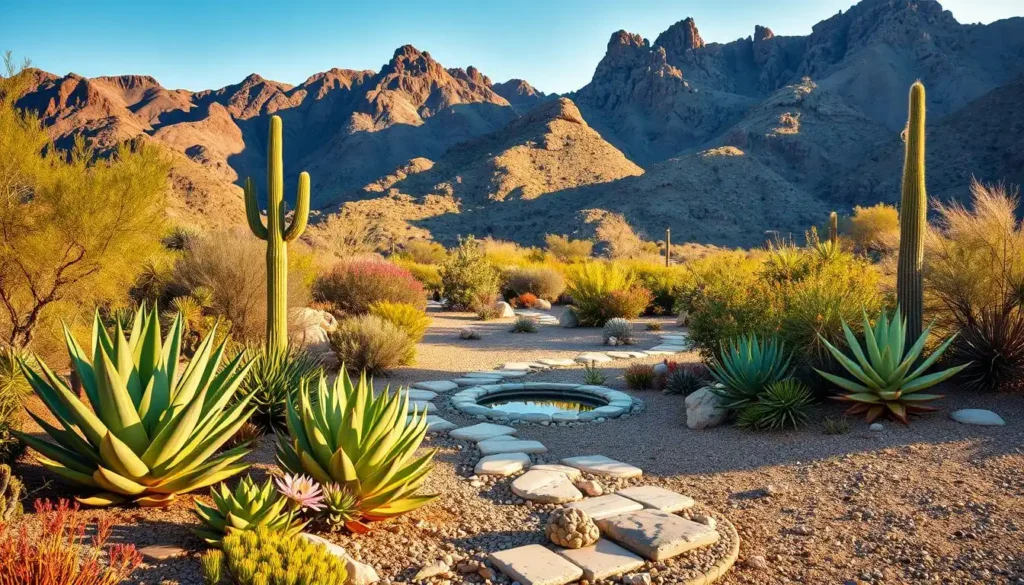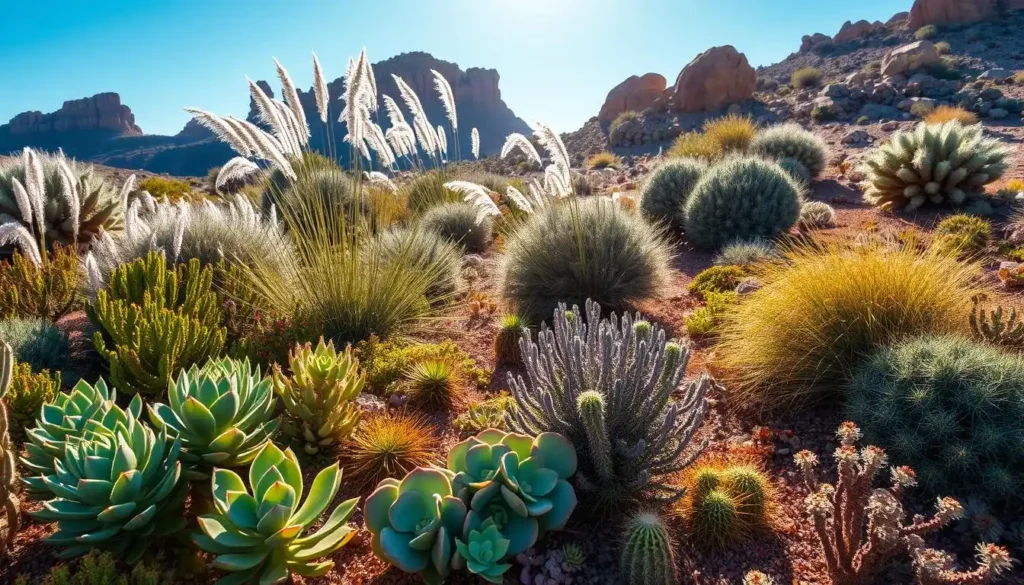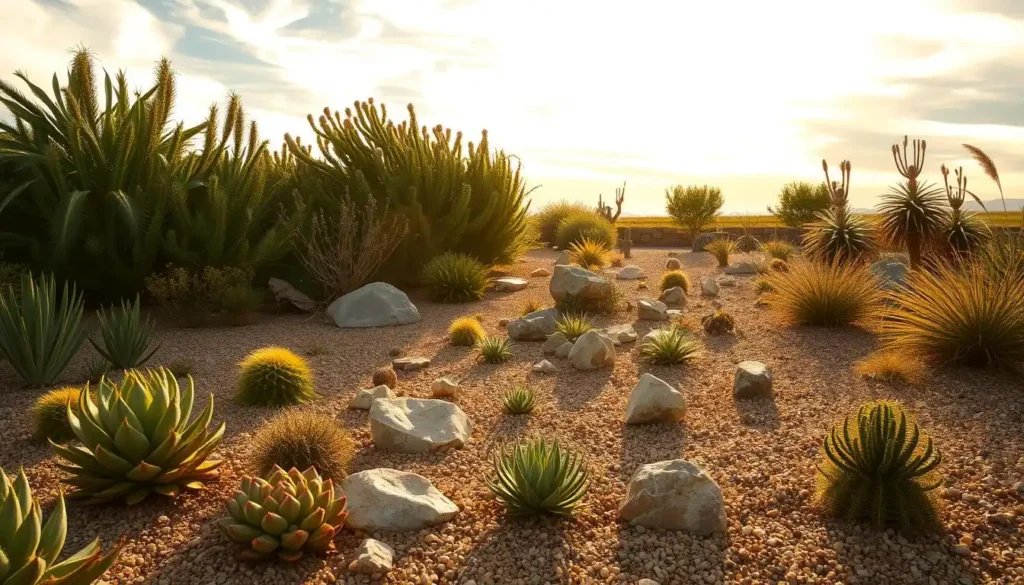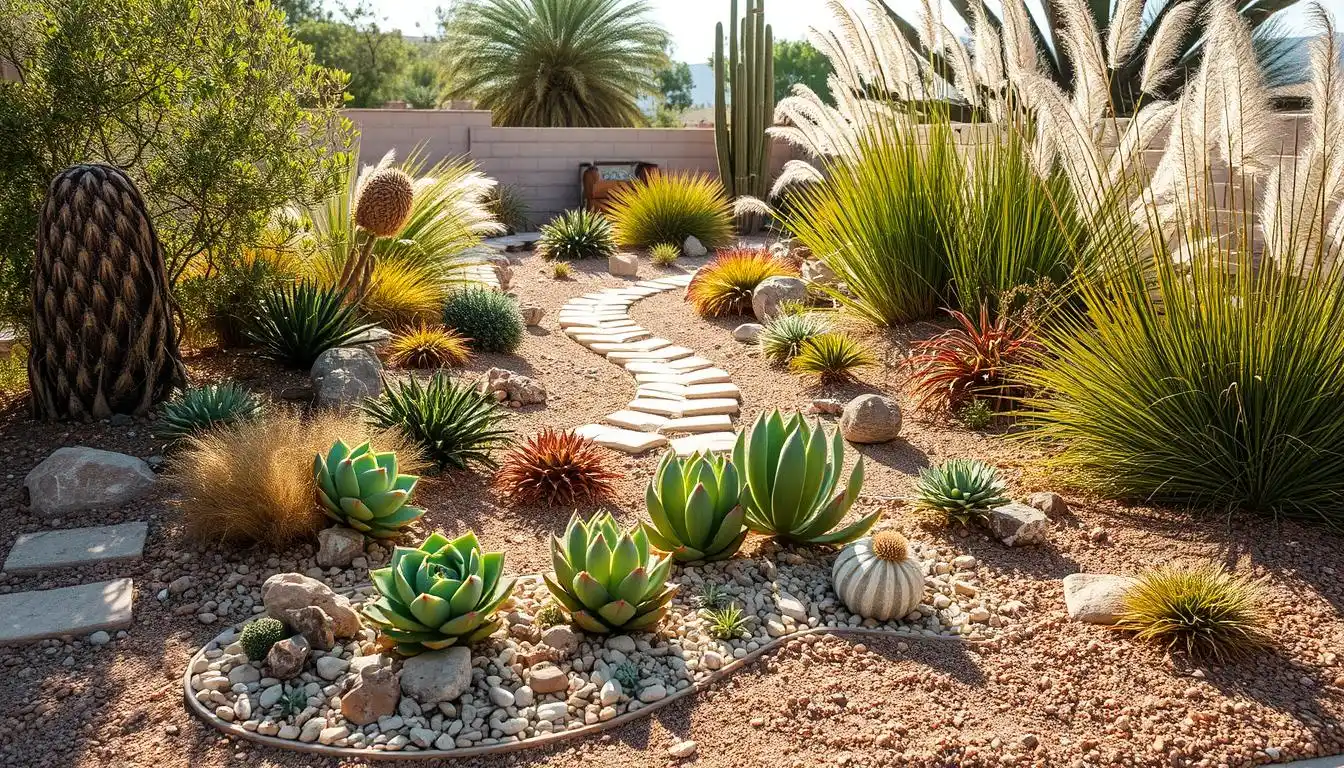Looking for ways to use less water and save time on gardening? A dry garden might be just what you need.
Dry gardens are made to grow well with little water. They’re great for saving water. You can make a stunning, eco-friendly outdoor area with the right plants and water systems.
The idea of dry gardens is becoming more popular. It’s especially good in places where saving water is key. This way, you help the planet and get a garden that’s easy to care for, saving you time and effort.
Key Takeaways
- Create a water-efficient garden with drought-tolerant plants.
- Reduce your environmental impact with sustainable gardening practices.
- Enjoy a low-maintenance outdoor space that saves you time.
- Incorporate efficient irrigation systems to minimize water waste.
- Discover the benefits of dry gardens for your home and the environment.
The Appeal and Purpose of Dry Gardens
Creating a dry garden is a smart move for a beautiful outdoor space. It saves water and cuts down on upkeep. Dry gardens, also known as drought-tolerant or water-wise gardens, grow well with little water.
What Defines a Dry Garden
A dry garden uses plants that don’t need much water. It also has efficient irrigation and soil management to save water. Plants native to dry areas or those that can survive with little moisture are often used.

Historical Roots and Modern Applications
Dry gardens have been around for a long time, especially in places where water is scarce. Now, they’re becoming popular everywhere as a green landscaping choice. Modern dry gardens use many plants and designs, making them both lovely and useful.
Who Benefits Most from This Gardening Style
This gardening style is great for people in areas with little rain or water limits. It’s also perfect for those wanting to use less water and do less gardening. By picking plants that don’t need much water, you can have a lively garden while saving resources.
Environmental and Economic Advantages of Water-Wise Landscaping
Water-wise landscaping lets you cut down on your environmental impact and still have a stunning garden. Dry gardens, in particular, bring many benefits. They help make gardening more sustainable and cheaper.
Significant Water Conservation Benefits
Dry gardens save a lot of water. By choosing plants for hot dry gardens, you use less water. These plants love dry conditions, so you don’t have to water them as often.

Reduced Maintenance Time and Effort
Dry gardens also mean less work for you. They need less watering and mowing. So, you can have a lovely garden without spending a lot of time on it.
Long-term Cost Savings on Resources
Dry gardens are good for your wallet too. They use less water and need less care. This means you save money over time. Here’s a look at the savings:
| Resource | Traditional Garden | Dry Garden |
|---|---|---|
| Water Consumption | High | Low |
| Maintenance Time | High | Low |
| Cost | High | Low |
Choosing water conservation with dry gardens is smart. It’s good for the planet and your wallet.
Fundamental Design Principles for Creating a Dry Garden
To make a stunning dry garden, you need to know the key design principles. A dry garden saves water and looks great. It thrives by understanding the climate and site conditions.
Assessing Your Climate and Site Conditions
Before designing your dry garden, check your local climate and site. Know the average rainfall, temperature, and soil type. Soil preparation is key for moisture and plant growth.
Planning for Microclimates and Sun Exposure
Microclimates in your garden affect plant survival. Shaded or wind-protected areas are good for plants needing more moisture. It’s also important to know how much sun your garden gets. Watching your garden’s sun patterns helps you decide.
Balancing Aesthetics with Practicality
A dry garden should look good and work well. Choose plants that are drought-tolerant and pretty. Hardscaping elements are also important for this balance.
Hardscaping Elements That Complement Dry Gardens
Elements like gravel or stone pathways, decorative rocks, and retaining walls make your garden look better. They also help with soil erosion and drainage.
| Hardscaping Element | Aesthetic Benefit | Practical Benefit |
|---|---|---|
| Gravel or Stone Pathways | Visually appealing, creates a sense of flow | Reduces soil compaction, improves drainage |
| Decorative Rocks | Adds texture and color | Helps retain soil moisture, suppresses weeds |
| Retaining Walls | Creates levels, adds depth | Prevents soil erosion, improves soil stability |

Best Plants for Hot Dry Gardens: Trees and Shrubs
Choosing the right plants is key for a dry garden. Drought-tolerant trees and shrubs are essential. They make your garden thrive.
Drought-Resistant Trees for Shade and Structure
Drought-resistant trees offer shade and structure. The Desert Willow (Chilopsis linearis) and Texas Sage (Leucophyllum frutescens) are great picks. They have deep roots and handle dry weather well.
These trees are not just beautiful. They also create microclimates that help other plants grow.
Water-Wise Flowering Shrubs for Year-Round Interest
Flowering shrubs add color and interest all year. Lavender (Lavandula spp.) and Rockrose (Cistus spp.) are drought-tolerant and flower beautifully. They keep your garden lively, even when it’s dry.
Native Options for Your Region
Native plants are perfect for dry gardens. They fit the local climate and soil. Native trees and shrubs need less care and water.
Choosing plants native to your area boosts your garden’s sustainability. It’s a smart choice for water-wise landscaping.
Establishment Care for Woody Plants
Proper care is vital for new trees and shrubs in dry gardens. Water them well when they’re new, and mulch to keep moisture in. Prune them to help them grow strong.
By doing these things, your plants will do well for a long time.
Perfect Plants for Dry and Sunny Areas: Perennials and Groundcovers
Areas with lots of sunlight and dry soil are perfect for certain plants. These perennials and groundcovers not only survive but also thrive. They do well in conditions that are tough for other plants.
Flowering Perennials That Thrive in Heat
Flowering perennials are great for sunny, dry spots. They come back every year, offering beauty with little care. Black-eyed Susans, Butterfly Weed, and Lavender are excellent choices. They’re drought-tolerant and attract pollinators, boosting your garden’s life.
Ornamental Grasses for Movement and Texture
Ornamental grasses are perfect for sunny, dry areas. They bring movement and texture to your garden. Blue Oat Grass and Pampas Grass are great for dry spots and add a striking look.
Low-Growing Groundcovers for Erosion Control
Groundcovers stop soil erosion in sunny, dry areas. They spread out, keeping the soil in place. Creeping Thyme and Sedum are top picks for dry conditions.
Creating Seasonal Interest with Minimal Water
To keep your dry garden interesting all year, mix plants that bloom at different times. Spring bloomers like Tulips and Daффodils are followed by summer bloomers like Yarrow and Russian Sage. Fall brings color with Asters and Chrysanthemums.
Succulents and Specialty Plants for Extreme Dry Gardens
For gardens in extremely dry conditions, succulents and specialty plants are the ultimate solution. These plants have adapted to survive in harsh, arid environments. They are perfect for dry gardens.
Architectural Succulents and Cacti
Succulents and cacti are known for their striking shapes and sizes. They add an architectural element to your dry garden. They store water in their leaves, stems, or roots, allowing them to thrive in dry conditions. Some popular varieties include:
- Agave: Known for their rosette shape and sharp leaves.
- Aloe: Famous for their healing properties and succulent leaves.
- Echinocactus: A type of cactus that is globe-shaped and covered in spines.
Mediterranean Herbs and Aromatics
Mediterranean herbs such as rosemary, thyme, and oregano are well-suited for dry gardens. They are drought-tolerant and add fragrance to your garden. These herbs can be used in cooking and can be planted alongside succulents for a diverse and resilient garden.
Bulbs That Thrive in Dry Conditions
Some bulbs, like tulips and daffodils, can thrive in dry conditions if planted correctly. They go dormant during the dry season, conserving water and energy. Planting bulbs in the fall allows them to bloom in the spring, adding color to your dry garden.
Container Gardening for Dry Conditions
Container gardening is an excellent way to manage dry conditions. It allows you to control the soil mix and drainage, ensuring that your plants receive the right amount of water. Use pots with good drainage holes and a well-draining potting mix to prevent waterlogged soil.
| Plant Type | Watering Needs | Sun Requirements |
|---|---|---|
| Succulents | Low | Full Sun |
| Mediterranean Herbs | Low to Moderate | Full Sun |
| Bulbs | Moderate during growth, Low during dormancy | Full Sun to Partial Shade |
Soil Preparation and Maintenance for Water Conservation
The key to a drought-tolerant garden is in its soil. To make your dry garden thrive, you need to know and improve your soil.
Understanding and Improving Your Soil Type
Your soil type greatly affects how it holds water and drains. Clay soils keep water but can be hard. Sandy soils drain fast but might not have enough nutrients. Adding organic matter can make your soil better.
For instance, compost can help sandy soils hold water better. It also helps clay soils drain better.
Effective Mulching Techniques
Mulching is key in dry gardens. It keeps moisture in, stops weeds, and controls soil temperature. Organic mulches like wood chips or straw work well and are good for the environment.
“Mulching is like giving your garden a protective blanket, keeping it cool and moist.” – Gardening Expert
Organic Matter Management in Dry Gardens
Managing organic matter is crucial for soil health. Adding compost or well-rotted manure can make your soil better.
Dealing with Compaction and Drainage Issues
Soil compaction can cause poor drainage and aeration. To fix this, don’t walk on your garden beds. Use mulch to prevent soil compaction.
| Soil Type | Water Retention | Drainage |
|---|---|---|
| Clay | High | Poor |
| Sand | Low | Good |
| Loam | Medium | Good |
Improving soil structure with organic amendments can also help with drainage and reduce compaction.
Smart Irrigation and Water Management Systems
To keep your dry garden healthy, think about using smart irrigation and water management. These systems help use water wisely, making sure your garden grows well without wasting water.
Drip Irrigation Installation and Benefits
Drip irrigation is a smart way to water your dry garden. It sends water straight to the roots, cutting down on evaporation and runoff. This method saves water and helps plants grow better.
Benefits of Drip Irrigation:
- Water conservation through reduced evaporation
- Improved plant health due to targeted watering
- Reduced weed growth
Rainwater Harvesting Methods
Rainwater harvesting is a smart way to manage water in dry gardens. It collects and stores rainwater for later use, cutting down on the need for city water.
Rainwater Harvesting Techniques:
| Method | Description | Benefits |
|---|---|---|
| Roof Collection | Collecting rainwater from rooftops | Easy to implement, reduces stormwater runoff |
| Surface Runoff Collection | Collecting rainwater from surface runoff | Can be used for larger water needs |
Watering Schedules and Techniques
Having a good watering schedule is key for your dry garden’s health. Knowing when and how to water can save a lot of water.
Technology for Water Conservation
Technology is important in smart irrigation systems. Sensors and smart controllers let you automate watering based on soil moisture, weather, and plant needs.
By using these technologies, you can make sure your dry garden gets the right water at the right time. This helps save water and keeps plants healthy.
Transforming Your Existing Landscape into a Dry Garden
You can make your garden water-efficient by following a few steps. This change saves water and cuts down on garden work.
Step-by-Step Conversion Process
First, check your garden’s soil and sunlight. Then, pick plants that don’t need much water. Use smart watering and mulching to save water.
Key steps include:
- Assessing your garden’s microclimates
- Selecting appropriate plants for dry conditions
- Implementing water-saving irrigation methods
Phased Approach for Budget-Conscious Gardeners
If you’re on a tight budget, start small. Begin with a small part of your garden. Then, grow it as you can and as your budget allows.
Finding Resources at Garden Nursery Oakland, CA and Beyond
Nurseries like the one in Oakland, CA, offer great advice. They help pick the right plants and share water-saving tips.
Common Challenges and Troubleshooting
Dealing with bad soil and pests can be tough. Use organic soil boosters and smart pest control to fix these issues.
“The key to a successful dry garden is preparation and patience.” With these tips and a bit of patience, you can have a lovely, eco-friendly dry garden.
Conclusion: Embracing the Sustainable Beauty of Dry Gardens
You now have the tools to create a stunning dry garden. It not only saves water but also adds beauty to your outdoor space. By embracing dry gardening, you’re taking a big step towards a more sustainable future.
Dry gardens are both beautiful and practical. They offer a calm and welcoming space while using less water. The plants and design tips in this article will help you create a stunning dry garden that does well in tough conditions.
As you turn your landscape into a water-saving oasis, you’ll cut down on your environmental impact. You’ll also create a home for local wildlife. The beauty of dry gardens shows the power of careful landscaping. With these guidelines, you’re ready to begin your journey.
FAQ
What are the best plants for dry sunny areas?
Succulents, drought-resistant trees, and flowering perennials are great for sunny spots. Ornamental grasses, Mediterranean herbs, and native plants are also good choices. Pick ones that fit your area’s climate.
How do I create a dry garden?
First, check your climate and site. Then, pick plants that love dry conditions. Add gravel or stone paths for looks and function.Use mulch and organic matter to help the soil. This makes your garden healthier and easier to care for.
What are the benefits of having a dry garden?
Dry gardens save a lot of water and need less care. They also save money over time. Plus, they’re good for the environment and can look beautiful.
Can I transform my existing landscape into a dry garden?
Yes, you can turn your yard into a dry garden. Start by looking at your current yard and picking spots to change. Do it bit by bit to make it easier.Look for help at garden stores like those in Oakland, CA. They can guide you.
How do I care for plants in a dry garden?
Water plants wisely with drip irrigation. Mulch around them to keep moisture in. Also, manage soil to keep it healthy.Make sure to care for new plants well. This helps them grow strong in dry conditions.
What are some smart irrigation systems for dry-gardens?
For smart watering, use drip irrigation and rainwater harvesting. Set up efficient watering times. Consider smart controllers to save even more water.
How do I improve soil in a dry-garden?
Know your soil type and fix it if needed. Mulch well and manage organic matter. Fix any soil problems like compaction and drainage.This makes your soil better for your plants. It helps them thrive in dry conditions.

